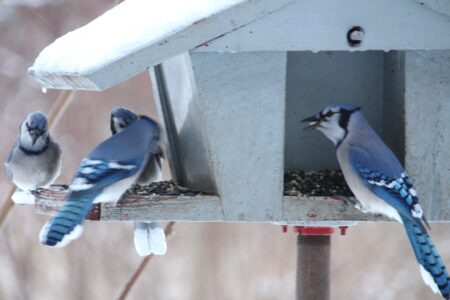Jul 27, 2025
A party of Blue Jays visits a feeder.
- A party of Blue Jays visits a feeder.
- A flock of tundra swans seen on big pond earlier this year.
A flock of geese, a school of fish, a swarm of bugs… all three of these things have something in common. They are all groupings of animals and the names we use for them. Some of the more common grouping names are flocks, herds, and packs. Those are terms we often use for the animals that humans have lived alongside for thousands of years. Flocks and herds are how we describe livestock, and humans domesticated packs of wolves into the dogs we see today.
Although there are common terms used for groupings of animals, nearly every type of animal has a specific word to describe a group of them. Some of my personal favorites are the terms used for the corvid family, which contains crows, jays, and magpies. A flock of crows can also be called a murder, a group of ravens is called a conspiracy, and for blue jays it is a party. The terms murder and conspiracy also make me think of the many myths and misconceptions around crows and ravens. To be fair, with how intelligent ravens are when it comes to problem solving and causing mischief, I can see why they were dubbed a conspiracy.
We’ve even come up with names for groups of animals that you would likely never see together in the wild. A group of owls is a parliament; however, owls are generally solitary creatures and would sooner chase another out of their territory than form a group. The one exception to this is the burrowing owl, which is social, however they are only found in the western half of the United States.
Beyond the words we use, animals live in groups because it is also an effective tool for survival. Deer and other prey animals group together because there is safety in numbers. While some members of the herd are eating, there are others who keep watch to warn of incoming danger. On the other hand, predators like wolves team up to take down prey that would be nearly impossible to challenge on their own. Humans are also social and we’ve found plenty of reasons to form crowds, whether it’s a holiday celebration, protest, or concert.
Social groups are also a way to communicate and share knowledge. Even chickens have a clear pecking order to show who’s in charge. Crows have been studied extensively about their social knowledge and learning. When presented with a challenging puzzle, if one member of the flock solves it, then the others will observe that bird and learn to solve it themselves by watching. Furthermore, crows can recognize faces and share associations with them, both positive and negative.
A flock of tundra swans seen on big pond earlier this year.
Another animal that communicates within a group are honeybees. These bees will use a waggle dance to tell others about where to find flowers, giving details like direction and distance from the hive. When talking about social animals, honeybees are especially worth noting. Each individual bee has an important role within the hive. For worker bees, the roles they hold change as they grow older. A young worker might feed her baby siblings or clean out honeycomb cells, but the older workers are the ones who go out to gather nectar and pollen from flowers. The queen keeps the hive together and is the only one capable of laying eggs. Male bees, or drones, will enter to mate with the queen before getting kicked out. In addition to communicating through dances, bees, like many insects, also use pheromones in much of their communication.
The world of social animals is a fascinating and complex one, and I know that I will stop and watch the next time I see a group, whether it’s observing the display hive at Audubon or watching flocks of birds interacting at a bird feeder.
Audubon Community Nature Center builds and nurtures connections between people and nature. ACNC is located just east of Route 62 between Warren and Jamestown. The trails are open from dawn to dusk and birds of prey can be viewed anytime the trails are open. The Nature Center is open from 10 a.m. until 4:30 p.m. daily except Sunday when it opens at 1 p.m. More information can be found online at auduboncnc.org or by calling (716) 569-2345.
WNY P-TECH in Dunkirk and CAM P-TECH in Springville have announced its fourth quarter high honor/honor/merit …
Copyright © 2025 Ogden Newspapers of New York, Inc. | https://www.observertoday.com | PO Box 391, Dunkirk, NY 14048 | 716-366-3000






